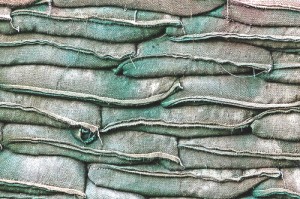You may be in an industry that is so basic, so fundamental, that the idea of a “next” probably seems absurd.
Take sandbags.
 I’m not sure how many companies make sandbags, but there are lots of places that sell them. Worldwide. Which makes sense: floods or overflows can happen anywhere. And, as Wikipedia points out, sandbags can be used for other purposes: “A sandbag (floodbag) is a sack made of hessian/burlap, polypropylene or other materials that is filled with sand or soil and used for such purposes as flood control, military fortification, shielding glass windows in war zones and ballast. Advantages are that burlap and sand are inexpensive, and that the bags can be brought in empty and filled with local sand or soil” [link]. One source traces the sandbag at least 250 years, to Napoleon’s time [link].
I’m not sure how many companies make sandbags, but there are lots of places that sell them. Worldwide. Which makes sense: floods or overflows can happen anywhere. And, as Wikipedia points out, sandbags can be used for other purposes: “A sandbag (floodbag) is a sack made of hessian/burlap, polypropylene or other materials that is filled with sand or soil and used for such purposes as flood control, military fortification, shielding glass windows in war zones and ballast. Advantages are that burlap and sand are inexpensive, and that the bags can be brought in empty and filled with local sand or soil” [link]. One source traces the sandbag at least 250 years, to Napoleon’s time [link].
What if your company manufactures sandbags? I’ll bet that assembling a team of managers and workers in your company to work at nextsensing would seem to make little or no sense. Other than managing costs to keep your prices low, what have you to fear from any and all competition?
Then again, maybe you should fear this 11-year-old from Florida.
Reports NBC News on its science page this week [link]:
An 11-year-old boy from Florida has designed a new kind of sandbag to better protect life and property from the ravages of saltwater floods. His invention took top honors at a science fair this week, earning him a $25,000 check and a trip to Costa Rica.
“Living in Florida, I’m keenly aware of hurricanes and saltwater flooding,” the Discovery Education 3M Young Scientist Challenge grand prize winner Peyton Robertson, who is a sixth grader at the Pine Crest School in Ft. Lauderdale, Fla., told NBC News.
“Super-storm Sandy really got me concerned about how people can prepare for that damage from flooding. But today, the most common method of flood protection is sandbags. They are really heavy and difficult to transport and leave gaps in between the bags. So, I redesigned the bag,” he explained.
Instead of sand, his bag is filled with a mixture of salt and an expandable polymer. When dry, it is lightweight, easy to move and easy to store. Once the bag is positioned, such as to create a barrier around a house, users hose it down with water. The polymer absorbs the water, swells and fills the volume of the bag.
But the top young scientist in America isn’t done. Adds NBC News: “The bags also have a novel interlocking mechanism that connects them at their midpoints in order to prevent gaps that floodwaters can penetrate. Robertson tested the bags in the bathtub and a kiddie pool where they easily outperformed traditional sand-filled sandbags. He next hopes to test them ‘in a real hurricane situation because that is the only way to figure out what glitches or whatever might be in the solution'”.
Astronaut Neil Armstrong once said about the program to land a man on the moon, “Well, I think we tried very hard not to be overconfident, because when you get overconfident, that’s when something snaps up and bites you.”
So, if you think your company doesn’t need a “next”, I urge you to think again. Having looked at many organisations in many fields, I can assure you that someone or something is just waiting to snap and bite.
Photo Credit: Leo Reynolds via photopin cc
